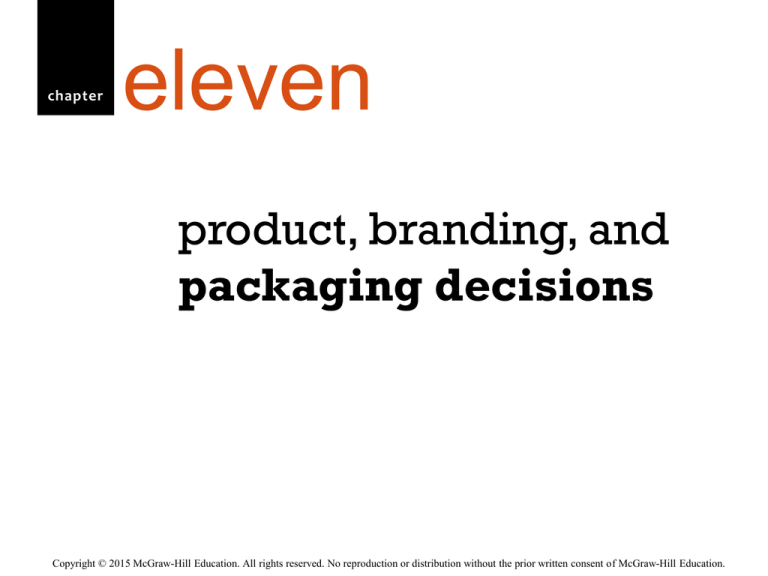
chapter
eleven
product, branding, and
packaging decisions
Copyright © 2015 McGraw-Hill Education. All rights reserved. No reproduction or distribution without the prior written consent of McGraw-Hill Education.
LEARNING OBJECTIVES
LO 11-1 Describe the components of a product.
LO 11-2 Identify the types of consumer products.
LO 11-3 Explain the difference between a product mix’s breadth
and a product line’s depth.
LO 11-4 Identify the advantages that brands provide firms and
consumers.
LO 11-5 Explain the various components of brand equity.
LO 11-6 Determine the various types of branding strategies used by
firms.
LO 11-7 Distinguish between brand extension and line extension.
LO 11-8 Indicate the advantages of a product’s packaging and
labeling strategy.
11-2
Complexity of Products
Michael Blann/Digital Vision/Getty Images
11-3
Types of Products
Customers show
such a strong
preference that
they will expend
considerable
effort to search.
Consumer is
willing to spend
minimum effort
to evaluate prior
to purchase.
Wedding Gowns
College Apparel
Antiques
Can goods
Shampoo
Candy
Shoes
Appliances
Cellphones
Fire extinguishers
Dictionary
Medical supplies
Consumers will
spend a fair
amount of time
comparing
alternatives
Consumers
either do not
normally think of
buying or do not
know about.
11-4
check yourself
1. Explain the three components of a product.
2. What are the four types of consumer
products?
11-5
Product Mix and
Product Line Decisions
Product Lines
Ready-to-Eat Cereal
Kellogg’s Corn Flakes
All-Bran
Apple Jacks
Cocoa Krispies
Frosted Mini-Wheats
Mueslix
Kellogg’s Raisin Bran
Froot Loops
Kashi
Special K
Rice Krispies
Toaster Pastries and
Wholesome Portable
Breakfast Snacks
Nutri-Grain
Special K
Kashi
Pop-Tarts
Bear Naked
Cookies and Crackers
Cheez-It
Keebler
Townhouse
Club
Famous Amos
Fudge Shoppe
Murray
Natural, Organic, and
Frozen
Eggo
Morningstar Farms
Kashi
Source: Kellogg’s 2010 annual report, http://annualreport2010.kelloggcompany.com/innovation.htm.
11-6
Product Mix and
Product Line Decisions
Breadth
•Number of product lines
Depth
•Number of categories
within a product line
Courtesy Pepsi Cola Company
11-7
check yourself
1. What is the difference between product line
breadth versus depth?
2. Why change product line breadth?
3. Why change product line depth?
11-8
Branding
Courtesy Mercedes-Benz USA, LLC;
Merkley & Partners/New York
A brand can use: Name, logo symbols, characters,
slogans, jingles and even distinctive packages.
Oscar Mayer Wiener
1965 Commercial
(One of America's
Best Ads)
11-9
McGraw-Hill
Companies, Inc.
What Makes a Brand?
Logos and
symbols
Characters
URLs
Slogans
www.eBay.com
©M. Hruby.
Brand name
Branding
Jingles/Sounds
“Law & Order”
11-10
Value of Branding for the Customer
Facilitate Purchasing
Establish Loyalty
Protect from Competition
Reduce Marketing Costs
Are Assets
Impact Market Value
Apple wins in the
Apple vs Samsung patent lawsuit
11-11
Brand Equity: Brand Awareness
2011 Rank
Brand
Country of
Ownership
2011 Brand Value
($ Billions)
1
Coca-Cola
U.S.
71.8
2
IBM
U.S.
69.9
3
Microsoft
U.S.
59.1
4
Google
U.S.
55.3
5
GE
U.S.
42.8
6
McDonald’s
U.S.
35.6
7
Intel
U.S.
35.2
8
Apple
U.S.
33.5
9
Disney
U.S.
29.0
10
Hewlett-Packard
U.S.
28.5
Source: From interbrand.com, http://www.interbrand.com/best_global_brands.aspx. Reprinted with permission.
11-12
Brand Equity: Perceived Value
• How do discount
retailers like Target,
T.J. Maxx, and H&M
create value for
customers?
Photo by Peter Kramer/Getty Images
11-13
Brand Equity: Brand Associations
©McGraw-Hill Companies Inc/Gary He, photographer
11-14
Brand Equity: Brand Loyalty
• Consumers are often
less sensitive to price
• Marketing costs are
much lower
• Firm insulated from
the competition
Copyright State Farm Mutual Automobile Insurance
Company 2005 Used by permission
11-15
check yourself
1. How do brands create value for the
customer and the firm?
2. What are the components of brand equity?
11-16
Brand Ownership
Manufacturer brands or
national brands
Private-label brands or
Store Brands
• Premium
• Generic
• Copycat
• Exclusive co-branded
11-17
Brand Extension
©M Hruby
State Farm Website
11-18
Brand Dilution
Evaluate the fit between
the product class
of the core brand
and the extension.
Evaluate consumer
perceptions of the
attributes of the core brand
and seek out extensions
with similar attributes.
Refrain from
extending the brand
name to too many
products.
Is the brand
extension distanced
enough from the
core brand?
11-19
Co-branding
©M Hruby
Zite: Personalized Magazine
11-20
Brand Licensing
Photo by D. larke Evans/NBAE via Getty Images.
11-21
check yourself
1. What are the differences among
manufacturer and private-label brands?
2. What is co-branding?
3. What is the difference between brand
extension and line extension?
4. What is brand repositioning?
11-22
Packaging
• What other packaging
do you as a consumer
find useful?
©M. Hruby.
11-23
Product Labeling
C Sherburne/PhotoLink/Getty Images
©The McGraw-Hill Companies, Inc/Elite Images
11-24






